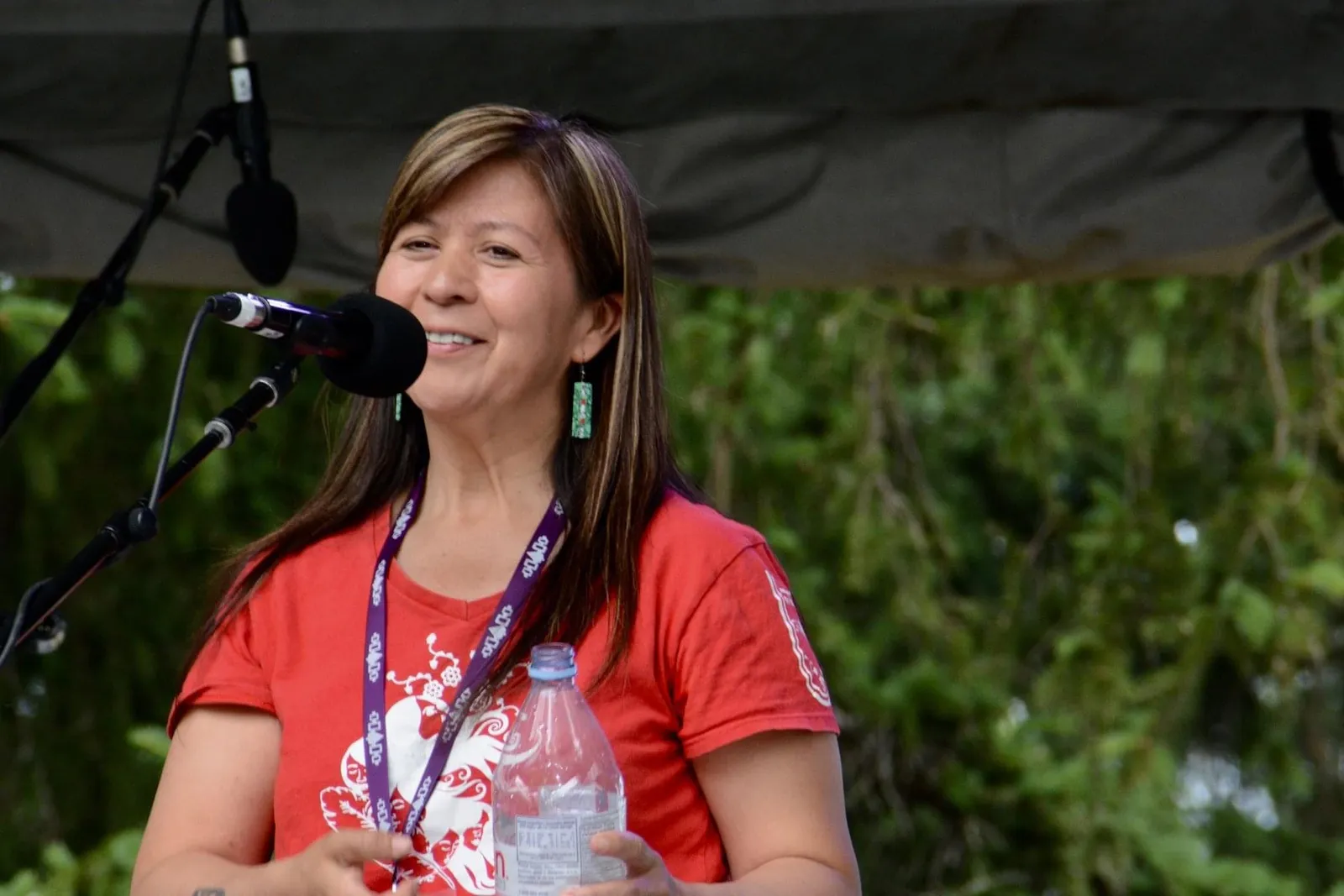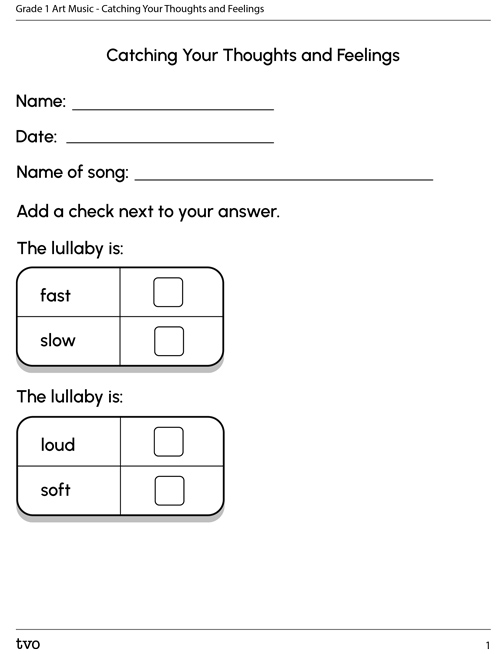Minds On
Today’s vocabulary
A quiet and soothing song or piece of music usually played for children. Also called a cradle song.
How fast or slow a piece of music is performed. Connected to the element of duration.
The level of softness or loudness, or intensity. Some examples include: crescendo, decrescendo; forte (f – loud), fortissimo (ff – very loud), mezzo forte (mf – moderately loud); piano (p – soft), pianissimo (pp – very soft), mezzo piano (mp – moderately soft).
Let’s get started!
Explore the following video, “Cradle Song of Southeast Alaska." It is a song created by the Haayk Foundation and sung by David R. Boxley. This video also includes lyrics for the song.
Video courtesy of Sealaska Heritage Institute
After exploring the video, consider the following questions:
- How might this song make someone feel?
- What is this song about? What makes you say that?
If you want some help getting started, press the ‘Hint’ button to reveal a clue.
Does the song go fast or slow? Is it loud or soft? What do the words tell you?
Record your ideas using a method of your choice.
Action
Get ready, get set…
The song we explored in the Minds On is called “Ts’iibn gya’wn ada sgwaytgn,” or “Close your eyes now and rest.” This song is a lullaby.
A lullaby is a song to call a child to sleep. A lullaby may also teach us things.

We are going to explore the lullaby again.
Before we explore it again, think about this question: What makes this song a lullaby?
Use the following question to help you search for clues:
Is the lullaby fast or slow?

Fast

Slow
Is the lullaby loud or soft?

Loud

Soft
What do the words tell us?

What does it tell us?
Let’s explore the song again and think about these questions.
Video courtesy of Sealaska Heritage Institute. Feb 22
Question time
Now let’s answer some questions about the song.
Press the ‘Answer’ button to learn more.
The lullaby has a soft or quiet volume.
In music, we call the volume of the music dynamics.
The dynamics of this lullaby are soft.
It is sung by one person.
There are no other instruments.
You can listen to an audio version of this answer here:

Loud or soft?
Let’s try another question.
Press the ‘Answer’ button to learn more.
It is slow.
In music, we call the speed of the music tempo.
The tempo of this lullaby is slow.
Like “Close your eyes now and rest”, many lullabies are sung slowly.
Singing slowly can be calming.
You can listen to an audio version of this answer here:

Fast or slow?
Test Your Skills!
What does it mean?
Let’s think a bit more about the lullaby.
What do the words in the lullaby tell us?
Press the ‘Answer’ button to find out.
The words in the lullaby tell a short story:
Line 1: Close your eyes now and rest,
In line 1, someone is calling the child to sleep.
Line 2: Bless the night.
Line 3: And you yawn as you wake.
In line 2 and 3, they are also saying thank you to the night until the sun rises again and it’s time to wake up again.
Go!
We are going to explore another lullaby.
This lullaby is written by Bear Fox and it is called, “Baby Song.”

Years ago, a friend who was going to become a Grandmother for the first time asked Bear Fox to write a song to greet the baby with. Since this time, this song has been sung to many babies including Bear Fox’s own grandchildren.
This lullaby comes from the Akwesasne Mohawk Nation.
The lullaby is sung in a language called Kanyen’kéha or Mohawk.
Explore the song lyrics and their English translation:
Shonkwaia'tison tahiateniehte (Our creator has sent a gift)
onen ieiohe ahsatonrie (it is time now for you to take a breath)
niawen, niawen tai sonhe (thank you, thank you for being here)
owira:a tsinenwe enkonnoronhkwake. (Baby, I will love you forever)
Satateriwakwenienstak. (Respect yourself)
Iohahi:io sathahita (Walk on a good path)
Sheriiwakwenienstak. (Respect)
iekhenistenha ohontsia (our mother the earth)
As you explore the lullaby, answer the following questions:
- Is the lullaby fast or slow?
- Is the lullaby loud or soft?
- What do the words tell you?
Are you ready? Here is the lullaby, “Baby Song.”
Baby Song
Test Your Skills!
Share your thoughts
How might you share the meaning of the song?
Share your thoughts using a method of your choice.

You can use pictures:

You can use words:

You can use movement or describe how someone might move:
Catching your thoughts and feelings
Let’s think some more about the lullaby “Baby Song.”
Record your thoughts in the following fillable and printable Catching Your Thoughts and Feelings organizer. You can also complete this activity using another method of your choice.

Press the Activity button to access Catching Your Thoughts and Feelings.
Activity (Open PDF in a new tab)Portfolio
Portfolio
Consider adding your ideas about the lullaby to your portfolio.
Consolidation
Putting it all together

You’ve made a new musical memory!
Using the words tempo and dynamics, share the most important or memorable things you experienced in this lesson.
Press the following tabs to reveal what tempo and dynamics mean.
Now it’s your turn to show what you know! You can choose to:
- draw a picture and label the important parts using the words tempo and dynamics
- tell someone using the words tempo and dynamics
- write about it using the words tempo and dynamics
- make a recording of yourself moving to the music or talking about what you experienced using the words tempo and dynamics
Reflection
How do you feel about what you have learned in this activity? Which of the next four sentences best matches how you are feeling about your learning? Press the button that is beside this sentence.
I feel…
Now, record your ideas about your feelings using a voice recorder, speech-to-text, or writing tool.
Press ‘Discover More’ to extend your skills.
Discover MoreDid you know?
Lullaby songs may be passed from older people to younger people, like grandparents to grandchildren.
They can also be passed from one community to another.
This is why they are sung in different languages.
The lullaby we explored in this learning activity, “Close your eyes now and rest,” comes from Southeast Alaska. It is sung in Sm’algyax, the language spoken by the Ts’msyen (Tsimshian) people. They are from from Southeast Alaska and Northwestern British Columbia. This is on the other side of Canada.
Here is the area on a map.

“Baby Song” comes from the Akwesasne Mohawk Nation.

Other lullabies
Do you know any lullabies?
- Is the lullaby fast or slow?
- Is the lullaby loud or soft?
- What do the words of the lullaby tell you?